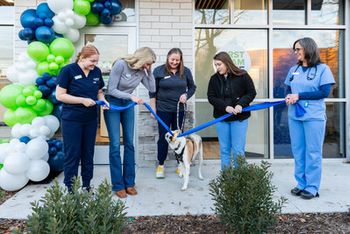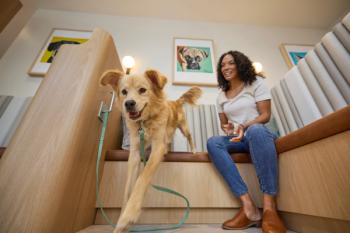
Two veterinary hospitals that prove the industry has changed
General vs. specialty, corporate vs. private, large vs. small-these hospitals represent two very different directions you could take when building your new practice.
Architects often see the world in of shades of grey, but looking at the contrasts—light and dark, black and white and so on—can often help us to see the “bones” underneath, e.g. the inherent structure.
The veterinary industry is similar in this way. Pocopson Veterinary Station in West Chester, Pa., and South Shore Animal Hospital in Weymouth, Mass., are two contrasting hospitals that are separated by a few hundred miles and connected by a history. While each one exemplifies a very workable solution as to how to design and build a veterinary hospital, they illustrate two very different directions in the veterinary industry. They provide a unique insight into how the veterinary industry has changed.
Let me give you a little background: In 1965, Dr. Gary Wiedwald graduated from The Ohio State University and moved to Boston. He and a number of other very talented doctors grew the South Shore Animal Hospital into one of the first large specialty practices in the Boston area. A number of years and additions later, it grew to be 10,000 square feet of medical space with a staff of a dozen or more doctors.
As one of the first large-scale specialty practices to thrive on the east coast, it represented two trends: the advent of the large mega practice built by entrepreneurs and the emergence of the specialty practice. During this time we spoke with Dr. Wiedwald and his associates about how they could expand the facility, but the time, money and space wasn’t available. They were landlocked, and in turn their growth was capped.
A few years later I got a call from Dr. Wiedwald. He had sold his interest in the South Shore hospital and had moved to rural Chester County, Pennsylvania. It seemed he had had enough of the hustle and bustle of running a mega practice and had decided there was something more to life. He had found a wonderful, little historic train station that he planned to convert into a veterinary hospital. The move to the woods of Pennsylvania showed how he’d reordered his priorities.
In 1891, the Wilmington and Northern Railroad built the Pocopson passenger station. The station was just one part of the railroad system, which was in turn a part of the giant coast-to-coast railway network that moved freight and people until the early 1950s when the airlines started taking over. For 60 years this station, like many others in little towns scattered across the country, was the hub of the town’s commerce. At its height the U.S. railroad network had 27 train stations in Chester County alone. Now there are only a few working stations left in Chester County.
The railroad system tied a dynamic and expanding network of agrarian and natural resources together. At the turn of the century the balance between urban and rural was definitely tipped toward the rural. This rural agrarian economy would have included large animal veterinary practitioners, but not companion animal veterinarians.
One hundred years after it was built, Dr. Wiedwald bought the train station building—which is listed on the Chester County Register of Historic Places—and hired Animal Arts to help him renovate it into a companion animal hospital. It was economically practical to do this, because Gary had the resources from cashing out of South Shore and because there were enough people living in the extended suburban areas that have grown up around Philadelphia.
Pocopson with its rural homesteads is located about 25 miles west of downtown Philly and beyond what we would typically call suburbia. Planners and architects call this extended and more rural suburbia “exurbia” and it represents the farthest reaches of the typical metropolitan sprawl. People move to these exurban areas for the simplicity of living in the country, so saving the Pocopson train station was important not only because it is a wonderful old building, but because it is an icon of this simple country life.
Looking at the plan for the Pocopson Veterinary Station, you see a veterinary hospital in miniature. It includes waiting/reception, one exam room and a full-service medical capacity including surgery and X-ray.
In 2007, Dr. Amy Kidd bought the practice. She graduated from the University of Pennsylvania in 1998, with an emphasis in critical and emergency care. Besides being a veterinarian, she is a wife and a mom with two kids.
About this same time VCA bought the South Shore hospital. At first VCA looked into expanding the existing facility, but there still wasn’t enough room on the site. Eventually an adjacent lot became available, VCA bought it and Animal Arts was hired to replace the existing South Shore Animal Hospital building with what would become an almost 27,000 square-foot, full-scale specialty/referral and emergency practice including 20 plus exam rooms, a CT and an MRI.
The expanded South Shore hospital is the other part of the story. It represents the corporate side of the veterinary industry, which for the most part had limited (until recently) its expansion into the veterinary world to purchasing existing, mature veterinary practices and then installing central “systems” to make them more efficient. South Shore represents the next step in the evolution–the building of larger, central specialty/referral facilities that are fed by a network of smaller veterinary practices.
So Pocopson and South Shore represent a snapshot of the veterinary industry: big vs. small, male vs. female, general vs. specialty, corporate vs. private, old vs. young, exurban vs. suburban vs. urban. When we first started designing and building veterinary hospitals, we used to know what the typical veterinarian and the veterinary industry looked like. These days life isn’t so simple. Some people might say the good old days were better. But in fact, I believe that as the veterinary market grows, fractures and morphs, it actually presents more opportunities—not less.
The veterinary industry is less shades of grey and more an industry of contrasts. And contrasts are good. If you take the time to understand the differences and what drives them, you can better appreciate what different veterinarians, clients and corporate entities bring to the whole. And in the end, it gives all of us more possibilities to build great hospitals.
Newsletter
From exam room tips to practice management insights, get trusted veterinary news delivered straight to your inbox—subscribe to dvm360.




